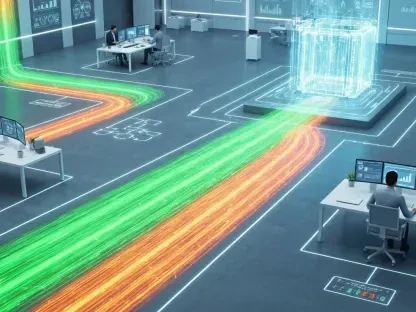In an era where technological advancements are reshaping every facet of society, the emergence of generative artificial intelligence (GenAI) stands out as both a groundbreaking innovation and a potential threat, particularly within the high-stakes realm of national security. Tools such as chatbots and large language models (LLMs) have been heralded for their ability to streamline research, enhance data analysis, and support decision-making processes for the U.S. Department of Defense (DoD) and intelligence agencies. Yet, beneath the surface of these efficiency gains lies a troubling question: could the growing dependence on such technologies be dulling the critical thinking skills that national security professionals rely on to navigate complex global challenges? This concern is not merely speculative but is rooted in emerging evidence and expert insights, suggesting that the very tools designed to empower might inadvertently weaken the cognitive foundation essential for maintaining a strategic edge. As the integration of GenAI accelerates across sectors, the implications for those tasked with safeguarding the nation—where decisions often carry life-and-death consequences—demand urgent attention. The balance between harnessing AI’s potential and preserving human intellect is becoming a pivotal issue, one that could redefine how the U.S. approaches security in an increasingly unpredictable world.
The Promise and Peril of GenAI
AI as a Double-Edged Sword
The dual nature of GenAI presents a compelling paradox for national security and beyond, offering transformative benefits while simultaneously posing significant risks to cognitive capabilities. On one hand, these tools are celebrated for their ability to enhance productivity across diverse fields, including defense, by automating labor-intensive tasks like synthesizing vast intelligence datasets or drafting complex reports. Projects such as Maven, utilized by the DoD, exemplify how AI can process information at unprecedented speeds, delivering actionable insights that support mission-critical operations. However, the efficiency comes with a hidden cost: the potential erosion of analytical and problem-solving skills that are indispensable in high-stakes environments. National security professionals often operate under intense pressure, where the ability to think independently and assess situations critically can mean the difference between success and catastrophic failure. The concern is that over-reliance on AI-generated outputs might reduce these professionals to mere validators of machine suggestions, rather than active architects of strategy. This subtle shift could undermine the very expertise that has long been a cornerstone of U.S. defense capabilities, raising questions about whether short-term gains in speed are worth the long-term cost to human judgment.
Delving deeper into this tension, the allure of GenAI lies in its capacity to act as an on-demand expert, providing immediate responses and reducing workload in environments where time is often a luxury. Yet, this convenience masks a more insidious effect, as habitual use of such tools may dull the mental sharpness required to tackle nuanced threats. In the context of national security, where adversaries continuously adapt and innovate, the ability to anticipate, analyze, and respond with originality is paramount. If AI becomes a crutch, the workforce risks losing the intellectual rigor needed to address issues like geopolitical rivalries or emerging cyber threats. Unlike other sectors where errors might be reversible, mistakes in defense can have irreversible consequences, amplifying the stakes of cognitive degradation. The challenge, therefore, is to integrate GenAI in a way that complements rather than supplants human thought, ensuring that technology serves as a tool for enhancement rather than a substitute for the irreplaceable human mind. This balance is not just a technical issue but a strategic imperative for maintaining national resilience.
Societal Integration and Generational Shifts
The pervasive adoption of AI across American society, from educational institutions to professional workplaces, is reshaping how future generations approach learning and problem-solving, with profound implications for national security. In K-12 classrooms, recent executive directives have accelerated the incorporation of AI tools, embedding them into the fabric of education at an early stage. This means that students who will one day fill critical defense roles are growing up in an environment where reliance on technology for tasks like research or writing is the norm. While this integration promises to equip them with cutting-edge skills, it also raises alarms about whether they will develop the deep analytical abilities needed to handle the complexities of national security. The risk is that constant exposure to AI assistance could hinder the intellectual struggle that fosters resilience and independent thought, leaving a workforce less prepared for roles where human judgment is non-negotiable. As this trend continues, the question looms: will the next generation of professionals possess the mental fortitude to address global challenges without leaning heavily on automated solutions?
Beyond the classroom, AI’s footprint in white-collar environments further amplifies these concerns, as approximately a third of professionals already use such tools regularly for tasks like idea generation or data analysis. This widespread penetration suggests that by the time today’s students enter the workforce, avoiding AI may be nearly impossible, embedding a culture of dependency that could extend into sensitive areas like defense. High school seniors today represent one of the last cohorts to recall education before the ubiquity of tools like ChatGPT, marking a generational divide that could have lasting effects. If critical thinking skills are not deliberately nurtured amidst this technological immersion, the ripple effects may manifest as a diminished capacity to innovate or respond to unforeseen threats in national security contexts. The urgency to address this shift lies in recognizing that societal integration of AI is not just a matter of convenience but a fundamental change in how cognitive skills are shaped, potentially weakening the very foundation that the nation’s security apparatus depends upon.
Cognitive Risks in High-Stakes Environments
Evidence of Skill Erosion
Emerging research into the cognitive impacts of GenAI reveals a troubling trend: the habitual use of these tools can shift mental focus from active problem-solving to passive acceptance of machine-generated content, with significant consequences for skill development. Studies, some still in preliminary stages, indicate that when individuals rely on AI for tasks like writing or analysis, there is a noticeable reduction in brain connectivity and creativity, as the mind engages less with the iterative process of thinking through problems. Educators have echoed these findings, observing that students who use GenAI often bypass the intellectual struggle inherent in learning, missing out on the development of clear reasoning and analytical depth. This trend is particularly concerning in contexts perceived as low-stakes, where users may offload critical thinking to AI without realizing the long-term impact on their abilities. Over time, this lack of practice can lead to a form of cognitive “deskilling,” akin to muscle atrophy from disuse, undermining the sharpness needed for more demanding scenarios. The evidence suggests that while AI can accelerate certain tasks, it may come at the expense of the mental agility that is crucial across various professional fields, especially those tied to national security.
Further exploration of this issue highlights that the erosion of skills is not merely an academic concern but a practical one, with parallels in specialized fields like medicine where similar effects have been noted. For instance, professionals who lean on AI assistance for diagnostic tasks risk losing the nuanced judgment that comes from hands-on experience, a phenomenon that could easily translate to defense roles where situational awareness and independent analysis are vital. The passive integration of AI outputs into workflows can create a feedback loop, where the less a skill is used, the weaker it becomes, ultimately reducing the capacity for original thought. This is especially alarming given that national security often requires unconventional approaches to unpredictable challenges, something that AI, bound by patterns in data, cannot fully replicate. Addressing this cognitive drift necessitates a reevaluation of how AI tools are deployed, ensuring they support rather than supplant the active engagement of the human mind. Without such measures, the gradual decline in critical thinking could leave professionals ill-equipped to handle the dynamic threats that define modern security landscapes.
Impact on National Security Workforce
The national security workforce operates in an environment where the demands for rapid, informed decision-making are unrelenting, making the preservation of critical thinking skills an absolute priority. Professionals in roles ranging from policy drafting to strategic planning within the DoD and intelligence agencies must navigate a landscape of multifaceted threats, including geopolitical tensions, cyber warfare, and climate-driven crises. These tasks rely heavily on the ability to analyze complex information, anticipate adversary moves, and craft innovative responses—skills that are often described as the backbone of effective performance. However, as AI tools like ChatGPT become integrated into federal operations, there is a growing risk that these core competencies could be undermined. The delegation of research and analytical tasks to GenAI might streamline processes, but it also threatens to reduce professionals to mere overseers of machine outputs, diminishing their capacity for independent judgment. This potential atrophy of cognitive sharpness is not just a personal loss but a strategic vulnerability, as the nation’s ability to respond to emerging dangers hinges on the intellectual prowess of its defenders.
Compounding this issue is the historical context of AI adoption within defense, which has been underway for several years through initiatives that showcase both its promise and its pitfalls. While projects have demonstrated the power of AI to handle vast intelligence data swiftly, the deeper integration of such technology raises questions about long-term workforce readiness. If current and future national security personnel are trained in environments where AI handles significant cognitive loads, the foundational skills of analysis and strategic foresight may not be adequately developed. This concern is particularly acute when considering the unpredictable nature of global threats, where rote reliance on AI-generated solutions could fail to address nuances that only human insight can grasp. The danger lies in creating a dependency that leaves the workforce unprepared for scenarios where technology falls short or is unavailable, highlighting the need for a deliberate approach to maintain the balance between leveraging AI and safeguarding the human intellect that remains the ultimate asset in national defense.
Urgent Need for Action
Policy and Educational Interventions
Addressing the hidden costs of GenAI on national security requires a proactive framework of policy and educational reforms designed to balance technological benefits with the preservation of critical thinking skills. One essential step is the implementation of a standardized AI literacy curriculum across schools, focusing not just on how to use these tools but on understanding their limitations and maintaining cognitive prowess. Such a program would teach students the history and terminology of AI while emphasizing the importance of independent thought over technological dominance. Additionally, clear guidelines must be established to delineate where AI can be applied effectively and where it should be restricted, preventing its use as a universal solution in contexts where human judgment is paramount. Policymakers and educators need to identify which skills can be safely offloaded to machines and which, like strategic analysis, must remain immutable, especially in defense roles. Robust governance is also crucial to guide the development and deployment of AI tools across sectors, ensuring that human cognition is not inadvertently undermined by unchecked adoption. These measures collectively aim to harness the advantages of GenAI while safeguarding the intellectual foundation that national security depends upon.
Another critical aspect of this intervention lies in tailoring these reforms to address the unique needs of the national security sector, where the stakes of cognitive erosion are exceptionally high. Beyond general education, targeted training programs for current and aspiring defense professionals should incorporate modules that reinforce analytical skills in AI-augmented environments. This could involve simulations where AI tools are used selectively, encouraging participants to rely on their own reasoning for key decisions while using technology as a supplementary resource. Furthermore, collaboration between government agencies, academic institutions, and tech developers is necessary to create ethical standards for AI integration, ensuring that tools are designed to support rather than replace human effort. By prioritizing these strategic interventions, the risk of deskilling can be mitigated, preserving the mental acuity needed to tackle complex threats. The urgency of implementing such policies cannot be overstated, as the window to shape AI’s role in society—and its impact on national security—is narrowing with each passing day, demanding a concerted effort to protect the human mind as a critical asset.
Harnessing Generational Awareness
The growing awareness among younger generations, particularly Gen Z, of the cognitive risks posed by GenAI presents a unique opportunity to drive meaningful change in how AI is integrated into national security and broader societal contexts. Many in this demographic, having witnessed the rapid rise of tools like ChatGPT during their formative years, express a desire for guidance on using AI responsibly without sacrificing their intellectual independence. This openness to learning offers a fertile ground for implementing reforms that emphasize the importance of critical thinking alongside technological proficiency. By engaging these young individuals through targeted educational initiatives and public awareness campaigns, a culture of balanced AI use can be fostered, one that values human judgment as much as machine efficiency. National security agencies could play a pivotal role by partnering with schools and universities to develop programs that highlight real-world scenarios where independent thought trumps automated solutions, inspiring the next generation to prioritize cognitive skills in their professional aspirations. This generational shift in perspective is a powerful lever for ensuring that the workforce of tomorrow remains equipped to handle the complexities of defense roles.
Equally important is the need to sustain this momentum by creating platforms for ongoing dialogue between younger generations, policymakers, and industry leaders to shape AI’s future trajectory. Forums and workshops can facilitate discussions on best practices for AI use, allowing Gen Z and beyond to contribute their insights on navigating a tech-saturated world. Such collaborative efforts can inform the development of policies that resonate with the lived experiences of those most affected by AI’s proliferation, ensuring relevance and effectiveness. In the context of national security, this approach can help cultivate a pipeline of professionals who view AI as a tool to enhance rather than define their decision-making processes. By capitalizing on this generational awareness, the foundation of critical thinking that underpins national defense can be reinforced, countering the risks of cognitive erosion. Reflecting on the strides made in recognizing these challenges, it becomes evident that the path forward lies in leveraging this collective consciousness to build a resilient framework where human intellect and technology coexist harmoniously, securing the nation’s future.









